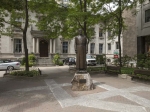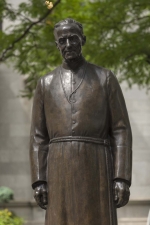Émile Brunet
Monument au frère André
1986
Presentation of the artwork
This is a replica of the sculpture of Brother André that is situated beside the eponymous chapel on the land belonging to St. Joseph’s Oratory; it was inaugurated on 2 November 1986 in the presence of mayor Jean Drapeau. Cast in London by Morris Singer Art Founders, from the plaster original conserved in the oratory’s museum, this posthumous copy sits at the centre of the former Beaver Hall Hill Square, now Place du Frère-André. The figure of Brother André, known during his lifetime for his closeness to the common people and his great accessibility, wears the habit of the priests of the Congrégation de Sainte-Croix. The posture and physiognomy portrayed transmit the humility and kindness of this priest, known for his many miracles as a healer. This artwork is typical of the academic production of the Canadian sculptor Jean-Émile Brunet. Associated events
Born Alfred Bessette in Mont-Saint-Grégoire, Brother André was the founder of St. Joseph’s Oratory. A member of the Sainte-Croix congregation, he was considered during his lifetime to be a great healer and a saint. His many “miraculous” healings, attributed to his intercession with St. Joseph, led to the construction of the oratory bearing the saint’s name (1924–55), a major urban pilgrimage site that receives thousands of visitors every year. Brother André, a man of the people to the end of his days, died at age 91 in Montréal. A religious figure forever inscribed on the collective imagination, Brother André was beatified on 23 May 1982.
Émile Brunet
Born into a family of makers of funerary monuments, Émile Brunet (Montréal 1893–1977) showed extraordinary artistic talent from a very young age, and he was awarded a scholarship by the Conseil des arts et manufactures du Québec when he was 14 years old. In 1920, he obtained a second scholarship that enabled him to attend the Chicago Art Institute. Three years later, he continued his education at the École nationale supérieure des beaux-arts in Paris, where he earned the title of “premier élève,” the equivalent of the Prix de Rome. In 1937, Brunet designed the Canadian pavilion for the Exposition universelle des arts et techniques de Paris. Among his best-known achievements are the monument to Sir Wilfrid Laurier (1927) on Parliament Hill in Ottawa and the statue of Maurice Duplessis (1977) on the south side of the National Assembly building in Québec City.
Awards and honours
- médaille d’argent au Salon annuel des artistes français, 1927
- médaille d'honneur et grand prix de l'Exposition universelle de Paris, 1937
Presentation of the artwork
This is a replica of the sculpture of Brother André that is situated beside the eponymous chapel on the land belonging to St. Joseph’s Oratory; it was inaugurated on 2 November 1986 in the presence of mayor Jean Drapeau. Cast in London by Morris Singer Art Founders, from the plaster original conserved in the oratory’s museum, this posthumous copy sits at the centre of the former Beaver Hall Hill Square, now Place du Frère-André. The figure of Brother André, known during his lifetime for his closeness to the common people and his great accessibility, wears the habit of the priests of the Congrégation de Sainte-Croix. The posture and physiognomy portrayed transmit the humility and kindness of this priest, known for his many miracles as a healer. This artwork is typical of the academic production of the Canadian sculptor Jean-Émile Brunet. Associated events
Born Alfred Bessette in Mont-Saint-Grégoire, Brother André was the founder of St. Joseph’s Oratory. A member of the Sainte-Croix congregation, he was considered during his lifetime to be a great healer and a saint. His many “miraculous” healings, attributed to his intercession with St. Joseph, led to the construction of the oratory bearing the saint’s name (1924–55), a major urban pilgrimage site that receives thousands of visitors every year. Brother André, a man of the people to the end of his days, died at age 91 in Montréal. A religious figure forever inscribed on the collective imagination, Brother André was beatified on 23 May 1982.
Émile Brunet
Born into a family of makers of funerary monuments, Émile Brunet (Montréal 1893–1977) showed extraordinary artistic talent from a very young age, and he was awarded a scholarship by the Conseil des arts et manufactures du Québec when he was 14 years old. In 1920, he obtained a second scholarship that enabled him to attend the Chicago Art Institute. Three years later, he continued his education at the École nationale supérieure des beaux-arts in Paris, where he earned the title of “premier élève,” the equivalent of the Prix de Rome. In 1937, Brunet designed the Canadian pavilion for the Exposition universelle des arts et techniques de Paris. Among his best-known achievements are the monument to Sir Wilfrid Laurier (1927) on Parliament Hill in Ottawa and the statue of Maurice Duplessis (1977) on the south side of the National Assembly building in Québec City.
Awards and honours
- médaille d’argent au Salon annuel des artistes français, 1927
- médaille d'honneur et grand prix de l'Exposition universelle de Paris, 1937






